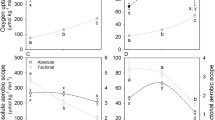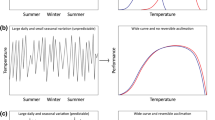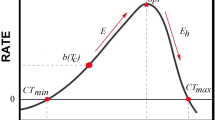Abstract
Animals can respond to temperature change by the following means: using physiological flexibility (including acclimation); or adapting; or migrating, with acclimation proposed as the major mechanism dictating prospects for survival in marine groups. In this study, 6 species of Antarctic invertebrate covering 4 phyla, Echinodermata, Mollusca, Brachiopoda and Crustacea were subjected to acclimation trials at 3°C for 60 days. Using acute upper lethal temperatures as a metric of ability to acclimate, only one species (Marseniopsis mollis) increased its acute upper limit. Furthermore, analysis of oxygen consumption on the urchin Sterechinus neumayeri and the amphipod Paraceradocus gibber showed their metabolic rates were also not compensated over the 60-day exposure period. Thus, 5 out of 6 species failed to acclimate to temperatures only 3.5°C above the annual average and 1–2°C above current summer maximum values. We discuss the proposal that the abilities of Antarctic marine species to adjust to elevated environmental temperatures are as limited, if not more so, than tropical species.




Similar content being viewed by others
References
Banti V, Mafessoni F, Loreti E, Alpi A, Perata P (2010) The heat-inducible transcription factor HsfA2 enhances anoxia tolerance in arabidopsis. Plant Physiol 152:1471–1483
Barnes DKA, Fuentes V, Clarke A, Schloss IR, Wallace M (2006) Spatial and temporal variation in shallow seawater temperatures around Antarctica. Deep Sea Res II 53:853–865
Brett JR (1956) Some principles in the thermal requirements of fishes. Q Rev Biol 31:75–87
Bullock TH (1955) Compensation for temperature in the metabolism and activity of poikilotherms. Biol Rev 30:311–342
Campos J, Van der Veer HW (2008) Autecology of Crangon crangon (L.) with an emphasis on latitudinal trends. Oceanogr Mar Biol Annu Rev 46:65–104
Chrousos GP (1998) Stressors, stress, and neuroendocrine integration of the adaptive response. Ann N Y Acad Sci 851:311–335
Clarke A (1991) What is cold adaptation and how should we measure it? Amer Zool 31:81–92
Clarke A (1998) Temperature and energetics: a review of cold ocean physiology. In: Pörtner HO, Playle RC (eds) Cold Ocean Physiology, Society for Experimental Biology Seminar Series no. 66: 3–30
Clarke A, Gaston KJ (2006) Climate, energy and diversity. Proc R Soc B: Biol Sci 273:2257–2266
Clarke A, Johnston N (1999) Scaling of metabolic rate and temperature in teleost fish. J Anim Ecol 68:893–905
Clarke A, Johnston NM (2003) Antarctic marine benthic diversity. Oceanogr Mar Biol Annu Rev 41:47–114
Cole NJ, Johnston IA (2001) Plasticity of myosin heavy chain expression with temperature acclimation is gradually acquired during ontogeny in the common carp (Cyprinus carpio L.). J Comp Physiol B 171:321–326
Compton TJ, Rijkenberg MJA, Drent J, Piersma T (2007) Thermal tolerance ranges and climate variability: a comparison between bivalves from differing climates. J Exp Mar Biol Ecol 352:200–211
Davenport J, Wong TM (1992) Effects of temperature and aerial exposure on 3 tropical oyster species, Crassostrea-Belcheri, Crassostrea-Iradelei and Saccostrea-Cucullata. J Thermal Biol 17:135–139
Dunton K (1992) Arctic biogeography: the paradox of the marine benthic fauna and flora. TREE 7:183–189
Franklin CE, Davison W, Seebacher F (2007) Antarctic fish can compensate for rising temperatures: thermal acclimation of cardiac performance in Pagothenia borchgrevinki. J Exp Biol 210:3068–3074
Fraser KPP, Peck LS, Clarke A (2004) Protein synthesis, RNA concentrations, nitrogen excretion and metabolism vary seasonally in the Antarctic holothurian Heterocucumis steineni (Ludwig 1898). Physiol Biochem Zool 77:556–569
Fry FEJ (1947) Effects of the environment on animal activity. University of Toronto Studies, biological series no 55. Publ Ontario Fish Res Lab 68:1–62
Fry FEJ, Brett JR, Clawson GH (1942) Lethal limits of temperature for young speckled trout (Salvelinus fontinalis) University of Toronto Studies, Biological Series no 54. Publ Ontario Fish Res Lab 66:1–35
Gonzalez-Cabrera JJ, Dowd F, Pedibhotla VK, Rosario R, Stanley-Samuelason D, Petzel D (1995) Enhanced hypo-osmoregulation induced by warm acclimation in Antarctic fish is mediated by increased gill and kidney Na+/K+-ATPase activities. J Exp Biol 98:2279–2291
Heise K, Estevez MS, Puntarulo S, Galleano M, Nikinmaa M, Pörtner HO, Abele D (2007) Effects of seasonal and latitudinal cold on oxidative stress parameters and activation of hypoxia inducible factor (HIF-1) in zoarcid fish. J Comp Physiol B-Biochem Syst & Env Physiol 177:765–777
Helmuth B (2009) From cells to coastlines: how can we use physiology to forecast the impacts of climate change? J Exp Biol 212:753–760
Hofmann GE, Place SP (2007) Genomics-enabled research in marine ecology: challenges, risks and pay-offs. Mar Ecol Prog Ser 332:249–255
Hudson HA, Brauer PR, Scofield MA, Petzel DH (2008) Effects of warm acclimation on serum osmolality, cortisla and hematocrit levels in the Antarctic fish Trematomus bernacchii. Pol Biol 31:991–997
IPCC (2007) Climate change 2007: synthesis report. Core writing team: In: Pachauri, R.K., Reisinger, A. (Eds.), Contribution of Work Groups I, II and III to the 4th Assessment Report of the Intergovernmental Panel on Climate Change. IPCC, Geneva, Switzerland
James MA, Ansell AD, Collins MJ, Curry GB, Peck LS, Rhodes MC (1992) Recent advances in the study of living brachiopods. Adv Mar Biol 28:175–387
Jin Y, DeVries AL (2006) Antifreeze glycoprotein levels in Antarctic notothenioid fishes inhabiting different thermal environments and the effect of warm acclimation. Comp Biochem Physiol B 144:290–300
Jumbam KR, Jackson S, Terblanche JS, McGeoch MA, Chown SL (2008) Acclimation effects on critical and lethal thermal limits of workers of the Argentine ant, Linepithema humile. J Insect Physiol 54:1008–1014
Klages M, Gutt J (1990) Comparative studies on the feeding behaviour of high Antarctic amphipods (Crustacea) in laboratory. Pol Biol 11:73–79
Lowe CJ, Davison W (2005) Plasma osmolality, glucose concentration and erythrocyte responses of two Antarctic notothenioid fishes to acute and chronic thermal change. J Fish Biol 67:752–766
McClintock JB, Slattery M, Heine J, Weston J (1992) Chemical defense, biochemical composition and energy content of three shallow-water Antarctic gastropods. Pol Biol 11:623–629
Meredith MP, King JC (2005) Rapid climate change in the ocean west of the Antarctic Peninsula during the second half of the 20th century. Geophys Res Let 32:L19604
Morley SA, Peck LS, Miller A, Pörtner HO (2007) Hypoxia tolerance associated with activity reduction is a key adaptation for Laternula elliptica seasonal energetics. Oecologia 153:29–36
Pearse JS, Giese AC (1966) Food, reproduction and organic constitution of the common Antarctic echinoid Sterechinus neumayeri (Meissner). Biol Bull Woods Hole 130:387–401
Peck LS (1989) Temperature and basal metabolism in two Antarctic marine herbivores. J Exp Mar Biol Ecol 127:1–12
Peck LS (2002) Ecophysiology of Antarctic marine ectotherms: limits to life. Pol Biol 25:31–40
Peck LS (2005) Prospects for survival in the Southern ocean: extreme temperature sensitivity of benthic species. Antarct Sci 17(4):497–507
Peck LS, Conway LZ (2000) The myth of metabolic cold adaptation: oxygen consumption in stenothermal Antarctic bivalves. In: Harper EM, Taylor JD, Crame JA (eds) The Evolutionary Biology of the Bivalvia. Geological Society, London, Special Publications, 177: 441–45
Peck LS, Colman JG, Murray AWA (2000) Growth and tissue mass cycles in the infaunal bivalve Yoldia eightsi at Signy Island, Antarctica. Pol Biol 23:420–428
Peck LS, Pörtner HO, Hardewig I (2002) Metabolic demand, oxygen supply and critical temperatures in the Antarctic bivalve Laternula elliptica. Physiol & Biochem Zool 75:123–133
Peck LS, Webb KE, Clark MS, Miller A, Hill T (2008) Temperature limits to activity, feeding and metabolism in the Antarctic starfish Odontaster validus. Mar Ecol Prog Ser 381:181–189
Peck LS, Clark MS, Morley SA, Massey A, Rossetti H (2009a) Animal temperature limits and ecological relevance: effects of size, activity and rates of change. Funct Ecol 23:248–256
Peck LS, Massey A, Thorne M, Clark MS (2009b) Lack of acclimation in Ophionotus victoriae: brittle stars are not fish. Pol Biol doi 10.1007/s00300-008-0532-y
Podrabsky JE, Somero GN (2006) Inducible heat tolerance in Antarctic nothothenioid fishes. Pol Biol 30:39–43
Pörtner HO (2010) Oxygen- and capacity-limitation of thermal tolerance: a matrix for integrating climate-related stressor effects in marine ecosystems. J Exp Biol 213:881–893
Pörtner HO, Knust R (2007) Climate change affects marine fishes through the oxygen limitation of thermal tolerance. Science 315:95–97
Pörtner HO, Peck LS, Hirse T (2006) Hyperoxia alleviates thermal stress in the Antarctic bivalve, Laternula elliptica: evidence for oxygen limited thermal tolerance? Pol Biol 29(8):688–693
Pörtner HO, Peck LS, Somero GN (2007) Thermal limits and adaptation in marine Antarctic ectotherms: an integrative view. Philos Trans R Soc Lond B 362:2233–2258
Precht H, Christopherson J, Hensel J (1954) Temperatur und Leben. Springer-Verlag, Berlin, p 514
Prosser CL (1973) Comparative animal physiology, 3rd edn. Saunders, Philadelphia, p 966
Robinson E, Davison W (2008a) The Antarctic notothenioid fish is thermally flexible: acclimation changes oxygen consumption. Pol Biol 31:317–326
Robinson E, Davison W (2008b) Antarctic fish can survive prolonged exposure to elevated temperatures. J Fish Biol 73:1676–1689
Schmidt-Nielsen K (1990) Animal Physiology: Adaptation and Environment, 4th edition edn. Cambridge University Press, Cambridge, p 602
Seebacher F, Davison W, Lowe CJ, Franklin CE (2005) A falsification of the thermal specialisation paradigm: compensation for elevated temperatures in Antarctic fishes. Biol Lett 1:151–154
Somero GN, De Vries AL (1967) Temperature tolerances of some Antarctic fishes. Science 156:257–258
Sorensen JG, Loeschcke V (2007) Studying stress responses in the post-genomic era: its ecological and evolutionary role. J Biosci 32:447–456
Stevens GC (1989) The latitudinal gradient in geographical range—how so many species coexist in the tropics. Am Nat 133:240–256
Stillman JH (2003) Acclimation capacity underlies susceptibility to climate change. Science 301:65
Stillman JH, Somero GN (2000) A comparative analysis of the upper thermal tolerance limits of eastern Pacific porcelain crabs, genus Petrolisthes: Influences of latitude, vertical zonation, acclimation, and phylogeny. Physiol & Biochem Zool 73:200–208
Tomanek L (2008) The importance of physiological limits in determining biogeographical range shifts due to global climate change: the heat-shock response. Physiol & Biochem Zool 81:709–717
Weibel ER (2000) Understanding the limitation of O-2 supply through comparative physiology. Resp Physiol 118:85–93
Whiteley NM, Taylor EW, El Haj AJ (1997) Seasonal and latitudinal adaptation to temperature in crustaceans. J Therm Biol 22:419–427
Wilson RS, Franklin CE (2002) Testing the beneficial acclimation hypothesis. TREE 17:66–70
Zachos J, Pagani M, Sloan L, Thomas E, Billups K (2001) Trends, rhythms and aberrations in global climate 65 Ma to present. Science 292:686–693
Ziegeweid JR, Jennings CA, Peterson DL (2008) Thermal maxima for juvenile shortnose sturgeon acclimated to different temperatures. Environ Biol Fish 82:299–307
Acknowledgments
We thank the staff of the Rothera Research station for their support in animal collection and maintenance, and this is especially so for the dive officers and marine assistants who were involved. This research was funded by NERC core funding to the British Antarctic Survey BIOFLAME programme.
Author information
Authors and Affiliations
Corresponding author
Additional information
Communicated by H. O. Pörtner.
Rights and permissions
About this article
Cite this article
Peck, L.S., Morley, S.A. & Clark, M.S. Poor acclimation capacities in Antarctic marine ectotherms. Mar Biol 157, 2051–2059 (2010). https://doi.org/10.1007/s00227-010-1473-x
Received:
Accepted:
Published:
Issue Date:
DOI: https://doi.org/10.1007/s00227-010-1473-x




